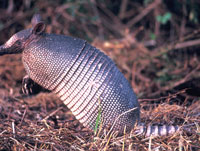 |
Armadillos are prolific diggers. They dig many burrows, as well as dig for food. They love to nest in rock piles, around trees or shrubs and under slabs. Their burrows are usually 15 to 25 feet long and unfortunately cause serious damage to tree roots. In many cases, this damage leads to the tree dying. These same burrows can lead to flooding when dug around crawl spaces and can undermine patio slabs or walkways. When they dig up the lawn in search of grubs, they again become a serious nuisance to the homeowner. In the deep south of this country the armadillo can be second only to deer as destroyers of home landscapes.
The most common armadillo, the nine-banded armadillo, looks little grey animal in armor. The body is 15 to 17 inches long and the tail about the same length. They can weight between 8 and 17 pounds.
The Nine-banded Armadillo is a mammal similar in form to an anteater. The bony, scaled shell of the critter protects it from attacks by predators. Unfortunately, armadillos often fall victim to automobiles and are frequently found dead on the roadside. “Why did the chicken cross the road?” “To show the armadillo how it was done.” Even though thousands of armadillos die from becoming road kill, their population is not in danger. Females bear identical quadruplets every year.
With no fur to warm them, armadillos do not like to be out when it is chilly. In the winter they work only during the warmest part of the day. In the heat of summer they tend to work at night.
The armadillo is the state mammal of Texas. Originally native to South America, the armadillo now ranges as far north as Texas, Oklahoma, Kansas and Louisiana east to Florida.
Armadillo’s Feeding Habits
The armadillo eats insects and other invertebrates. It is skilled at digging for grubs. It occasionally eats berries and bird eggs.

